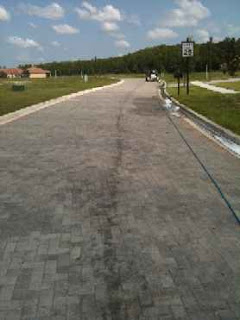 |
| Illustration 1: Typical Example of a Diesel Tanker Truck Rollover on a rural road in winter |
In April, 2012, a tanker truck,
containing a full load of diesel fuel, was disabled and rolled over
on a highway in Northern Ontario, spilling diesel fuel onto the
adjacent land, wetland, and waterway. The truck was removed and an
initial site clean up was completed. Representatives from the
MOE(Ministry of the Environment) and MNR(Ministry of Natural
Resources) were consulted, soil and water samples were taken, and the
residual amount of contamination was determined to be sufficient to
initiate a remediation program as soon as possible. The impacted
area was approximately 50 ft. X 50 ft. X 1-2 ft of depth. The water
table was below the impacted site at approximately 5 ft. (initial
levels of TPH were determined to be 300,000 ppm(parts per million) on
site).
The client called our office and
advised us of the details involved and we put together a treatment
program to address the particular characteristics of the site –
large wetland area on one side of the road where the tanker had lost
the fuel, with a waterway leading out of the wetland into a culvert
below the roadway and out to a creek bed on the other side of the
road.
Product was prepared and shipped to the
contractor's location and delivered the following day. Over the next
4 days the site received 4 – 6 inches of snow. In the meantime,
the contractor was building his equipment to treat the site and he
was able to apply the first treatment as the snow was melting – a
few days later. Our remediation plan called for a staged dosing of
oil eating microbes, natural surfactants plus nutrients for a period
of 35 days. Readings were taken on the 25th day and the
TPH had dropped to below 6000 ppm. On the 50th day
additional readings were taken and levels were below detectable range
for TPH but a few individual fractals were reported in the 200-250
ppb(parts per billion) range. Even though the microbes were
continuing to reduce the hydrocarbons, an additional dose of microbes
was added on the 61st day, just to be sure that the site
would be released as clear in the next few days.
Independent readings were taken at the
site and they confirmed our preliminary findings. The site was
released and the bog was only minimally impacted by the remediation
process.
Our products are used daily by
professionals in all seasons to treat situations like this one – if
you encounter a situation like this give us a call at our toll free
number – 866 621 8244 Monday – Friday 9:00 – 5:00 Eastern time
and we'll be happy to provide you with a timely, cost effective
solution to hydrocarbon contaminated soil or water. Come to our
website at www.eatoils.com to
see our other products and information.
















